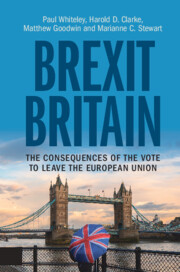43 results
Epilogue
-
- Book:
- Family Matters
- Published online:
- 27 May 2024
- Print publication:
- 31 July 2024, pp 267-273
-
- Chapter
- Export citation
Introduction
-
- Book:
- Family Matters
- Published online:
- 27 May 2024
- Print publication:
- 31 July 2024, pp 1-28
-
- Chapter
- Export citation
Introduction: What Difference Do Governments Make?
-
-
- Book:
- The Conservative Effect, 2010–2024
- Print publication:
- 27 June 2024, pp 1-3
-
- Chapter
- Export citation
2 - External Shocks
-
-
- Book:
- The Conservative Effect, 2010–2024
- Print publication:
- 27 June 2024, pp 37-70
-
- Chapter
- Export citation
14 - The Realigning Party System
-
-
- Book:
- The Conservative Effect, 2010–2024
- Print publication:
- 27 June 2024, pp 446-465
-
- Chapter
- Export citation
15 - Elections and Voting
-
-
- Book:
- The Conservative Effect, 2010–2024
- Print publication:
- 27 June 2024, pp 466-507
-
- Chapter
- Export citation
1 - Thirteen Wasted Years (1951–1964)?
-
-
- Book:
- The Conservative Effect, 2010–2024
- Print publication:
- 27 June 2024, pp 4-36
-
- Chapter
- Export citation
Chapter 6 - The French Revolution
- from Part I - Life and Times
-
-
- Book:
- Goethe in Context
- Published online:
- 16 May 2024
- Print publication:
- 23 May 2024, pp 57-65
-
- Chapter
- Export citation
Self-reported political ideology
-
- Journal:
- Political Science Research and Methods , First View
- Published online by Cambridge University Press:
- 22 February 2024, pp. 1-22
-
- Article
-
- You have access
- Open access
- HTML
- Export citation
Chapter 13 - Trigeminal Neuralgia
- from Part III - Chronic Pain Conditions Head and Neck
-
-
- Book:
- Cambridge Handbook of Pain Medicine
- Published online:
- 01 December 2023
- Print publication:
- 14 December 2023, pp 81-85
-
- Chapter
- Export citation
1 - Welcome to Brexit Britain
- from Part I - The Short Term
-
- Book:
- Brexit Britain
- Published online:
- 25 April 2023
- Print publication:
- 04 May 2023, pp 3-23
-
- Chapter
- Export citation
5 - The Johnson Breakthrough
- from Part I - The Short Term
-
- Book:
- Brexit Britain
- Published online:
- 25 April 2023
- Print publication:
- 04 May 2023, pp 104-136
-
- Chapter
- Export citation
3 - Political Paralysis
- from Part I - The Short Term
-
- Book:
- Brexit Britain
- Published online:
- 25 April 2023
- Print publication:
- 04 May 2023, pp 45-74
-
- Chapter
- Export citation
2 - Getting Brexit Done
- from Part I - The Short Term
-
- Book:
- Brexit Britain
- Published online:
- 25 April 2023
- Print publication:
- 04 May 2023, pp 24-44
-
- Chapter
- Export citation
4 - The Collapsing Party System
- from Part I - The Short Term
-
- Book:
- Brexit Britain
- Published online:
- 25 April 2023
- Print publication:
- 04 May 2023, pp 75-103
-
- Chapter
- Export citation

Brexit Britain
- The Consequences of the Vote to Leave the European Union
-
- Published online:
- 25 April 2023
- Print publication:
- 04 May 2023
6 - The Meaning of Conservative
- from Part I - Science
-
- Book:
- Five Times Faster
- Published online:
- 19 March 2023
- Print publication:
- 06 April 2023, pp 59-65
-
- Chapter
- Export citation
19 - Indian Summer or Conservative Winter?
-
-
- Book:
- The Cambridge Companion to Winston Churchill
- Published online:
- 19 January 2023
- Print publication:
- 26 January 2023, pp 379-395
-
- Chapter
- Export citation
3 - Property Theory and the State
- from Part I - Squatting and the State
-
- Book:
- Squatting and the State
- Published online:
- 11 August 2022
- Print publication:
- 25 August 2022, pp 143-164
-
- Chapter
- Export citation
THEOREMS OF HYPERARITHMETIC ANALYSIS AND ALMOST THEOREMS OF HYPERARITHMETIC ANALYSIS
- Part of
-
- Journal:
- Bulletin of Symbolic Logic / Volume 28 / Issue 1 / March 2022
- Published online by Cambridge University Press:
- 31 March 2022, pp. 133-149
- Print publication:
- March 2022
-
- Article
-
- You have access
- Open access
- HTML
- Export citation













